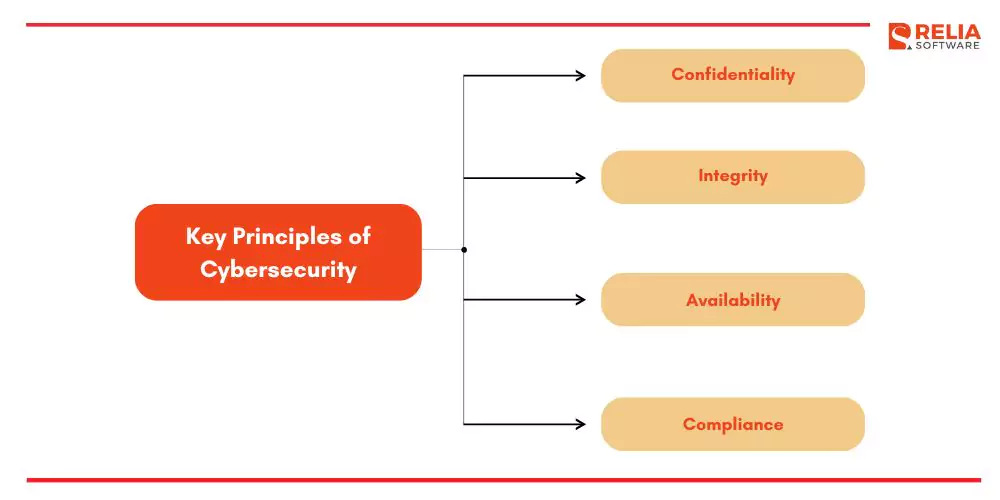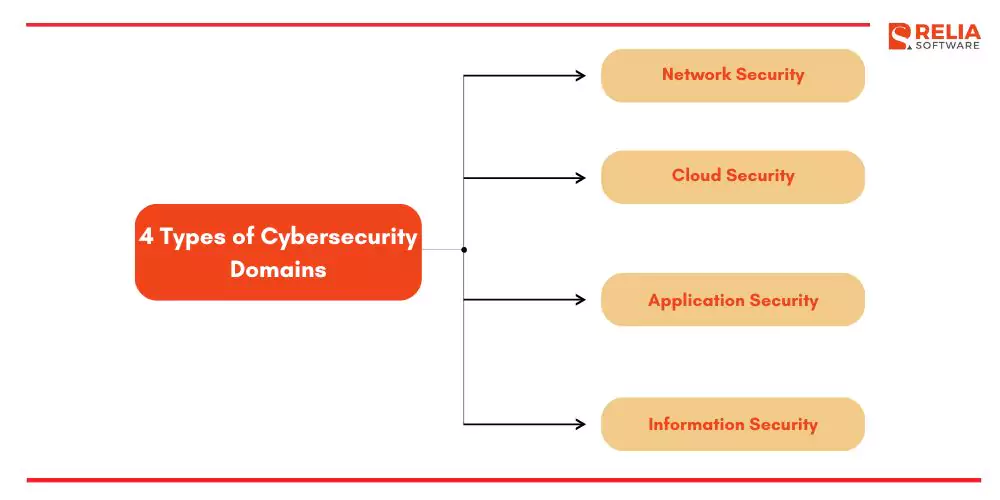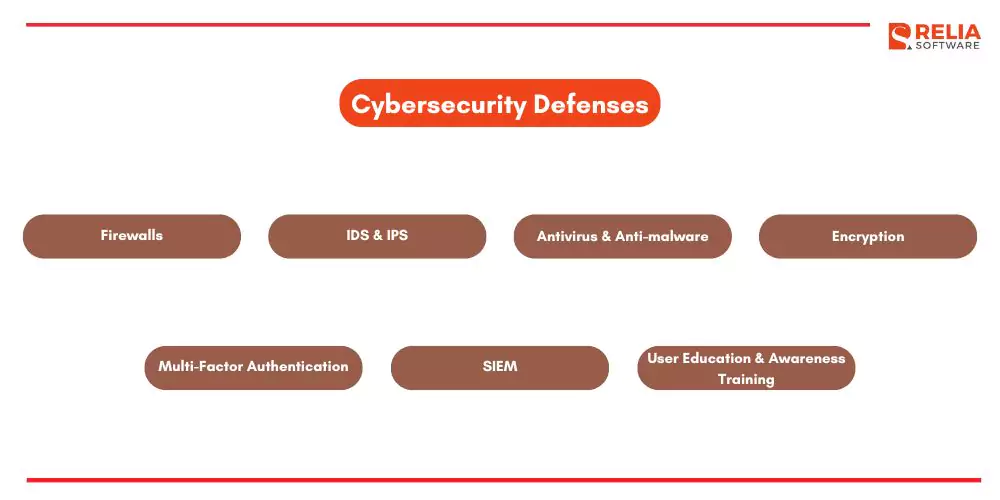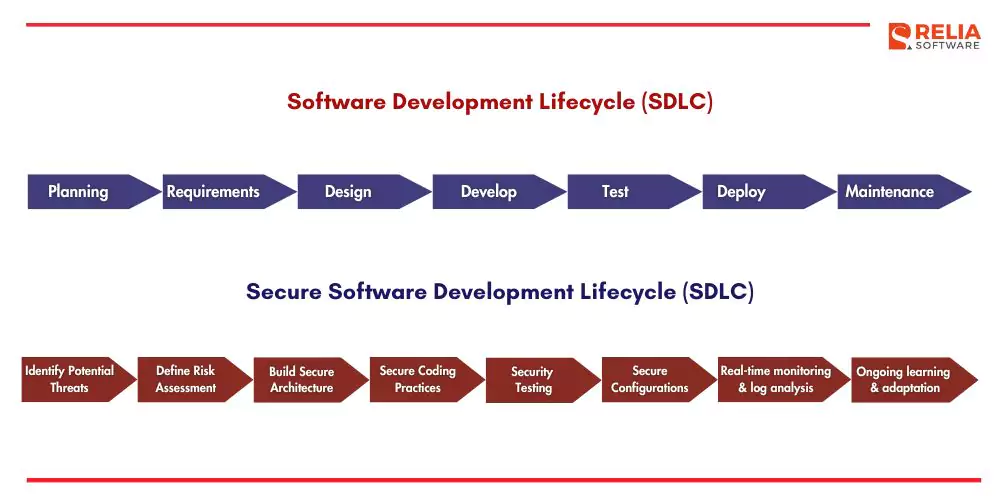Did you know that over 75% of applications have at least one security flaw that hackers could exploit (Comparitech)? Such vulnerabilities create critical entry points for cybercriminals, often leading to serious issues for organizations if they go unfixed. This statistic highlights the urgent need for proactive cybersecurity practices throughout the software development lifecycle.
In this article, we’ll explore essential principles and best practices for safeguarding software from potential threats. You will learn about common cyber threats, core defense strategies, and practical ways to embed cybersecurity measures in software development workflows effectively.
What Is Cybersecurity in Software Development?
Cybersecurity in software development is the proactive integration of security measures and practices throughout the software development lifecycle (SDLC) to protect applications, data, and systems from cyber threats and vulnerabilities. This approach focuses on safeguarding the confidentiality, integrity, and availability (CIA triad) of data within the software and its underlying infrastructure.
Essentially, cybersecurity is about embedding security into software from the very beginning rather than adding it in later. As software systems become more complex and interconnected, maintaining data protection and secure coding standards has become essential to developing resilient software.

>> Read more: What is Security Testing in Software Testing?
8 Common Cybersecurity Threats
>> You may get interested in: Common Software Development Challenges
Malware
Malware, or malicious software, is a broad category that includes viruses, worms, Trojans, ransomware, and spyware. These programs are designed to infiltrate, damage, or disable computers and networks. It is typically for data theft or unauthorized access. 4 main malware types include:
- Viruses: Attach to files, spreading and causing damage across systems.
- Worms: Self-replicate, infecting multiple devices without a host file, often impacting entire networks.
- Trojans: Appear as legitimate software but execute harmful actions, including data theft and remote access.
- Ransomware: Encrypts files and demands a ransom, increasingly targeting critical infrastructures like hospitals.
Social Engineering & Phishing
Social engineering involves manipulating individuals to reveal confidential information or perform certain actions. Phishing is a type of social engineering that deceives users by posing as legitimate entities to collect sensitive information, such as usernames, passwords, or credit card details. These attacks often appear through emails or instant messages that seem to originate from trusted sources. 2 types of phishing are:
- Spear Phishing: Targets specific individuals or groups, impersonating trusted entities to deceive users.
- Whaling: A targeted phishing attack directed at high-profile individuals (e.g., executives) to access sensitive data, leveraging their authority or influence.
Denial of Service (DoS) and Distributed Denial of Service (DDoS) Attacks
A Denial of Service (DoS) attack aims to disrupt the normal functioning of a network, system, or website by overwhelming it with excessive traffic, making it inaccessible to legitimate users. Distributed Denial of Service (DDoS) attacks are a more advanced version, using multiple compromised systems (bots) to flood the target with traffic, complicating detection and mitigation due to the distributed nature of the attack.
Man-in-the-Middle (MitM) Attacks
Man-in-the-Middle (MitM) attacks occur when an attacker intercepts or alters communications between two parties, compromising the privacy and security of data. These attacks often exploit unsecured Wi-Fi networks or set up fake websites to capture login credentials.
SQL Injection
SQL Injection is a type of cyberattack where malicious SQL code is injected into a web application to manipulate or compromise its database. 3 common types are:
- In-band SQL Injection: The attacker receives results directly within the application's response.
- Out-of-band SQL Injection: Results are redirected to a remote server.
- Blind SQL Injection: The attacker infers information based on the application’s behavior without directly viewing results.
Cross-Site Scripting (XSS)
Cross-site scripting (XSS) is a web vulnerability that enables attackers to inject malicious code into web pages viewed by users. 3 types of XSS are:
- Stored XSS: Malicious code is stored on the server and activated when users visit the affected page.
- Reflected XSS: Code is reflected from the server to the browser, often through URLs or form fields.
- DOM-based XSS: Executes directly in the Document Object Model (DOM), often without server involvement.
Zero-Day Exploits
Zero-day exploits are vulnerabilities in software or hardware that are unknown to the vendor, leaving them exposed until a security patch is available. Because the vendor is unaware of these vulnerabilities, it is challenging to defend against zero-day attacks effectively.
Supply Chain Attacks
Supply chain attacks target vulnerabilities within the development ecosystem by exploiting third-party libraries, dependencies, or vendor systems. Modern software often relies on external components, and a compromised library or update can unintentionally introduce security risks to an application.3 common types of this attack include:
- Software Supply Chain Attacks: Introduce malicious code into software during development or distribution.
- Hardware Supply Chain Attacks: Insert malicious components into hardware.
- Cloud Service Provider Attacks: Infiltrate cloud providers to access customer data and infrastructure.
>> Read more: An Ultimate Guide To Web Application Security for Businesses

Key Principles of Cybersecurity in Software Development
Confidentiality
Confidentiality ensures that sensitive information is accessible only to authorized individuals and systems, protecting data privacy and preventing unauthorized access. Techniques like encryption, access control, and authentication (e.g., passwords, biometrics) are essential, ensuring that only approved users can view and manage confidential data. This principle is especially critical in industries like finance and healthcare that handle high-risk information.
Integrity
Integrity ensures data remains accurate, consistent, and trustworthy by preventing unauthorized alterations. Methods like hashing, digital signatures, and checksums verify that data remains unchanged during storage or transfer, supporting data reliability across all stages.
Availability
Availability guarantees that information and resources are accessible to authorized users when needed, supporting system reliability and operational resilience. This principle demands that systems remain operational during cyberattacks or unexpected outages, using strategies like redundancy, load balancing, regular maintenance, and disaster recovery planning.
Compliance
Compliance involves adhering to legal, regulatory, and industry standards that govern data security and privacy. Standards such as GDPR, HIPAA, and PCI DSS enforce specific security protocols to protect sensitive information and safeguard user rights. Compliance helps organizations avoid penalties, build customer trust, and ensure responsible data management.
>> Read more: Detailed Explanation of 7 Software Testing Principles

4 Cybersecurity Domains in Software Development
Network Security
Network security protects the communication channels and infrastructure that software relies on, guarding against unauthorized access, interception, or tampering. Key components include:
- Firewalls: Act as a barrier between trusted development environments and untrusted networks, filtering traffic to safeguard applications.
- Intrusion Detection Systems (IDS): Monitor networks for malicious activities that could compromise the development or production environment.
- VPNs (Virtual Private Networks): Ensure secure remote access for developers working across distributed environments by encrypting data over public networks. For those exploring different providers, here are some alternatives to Proton worth considering.
- Encryption: Secures data in transit and at rest, preventing unauthorized interception.
Cloud Security
Cloud security is dedicated to protecting data that is stored, processed, and transmitted within cloud environments. Key measures include:
- Data Encryption: Encrypt sensitive data before cloud storage to prevent unauthorized access.
- Identity and Access Management (IAM): Manages permissions, allowing only authorized developers and system administrators to access development resources, often used with multi-factor authentication.
- Compliance and Governance: Follow data protection regulations and industry best practices for cloud-hosted applications.
- Security Monitoring: Deploy tools to detect and respond to suspicious activities or potential breaches in cloud environments.
Application Security
Application security aims to protect applications from exploitable vulnerabilities introduced during the software development lifecycle. Essential measures include:
- Secure Coding Practices: Follow coding standards to prevent issues like SQL injection and cross-site scripting (XSS).
- Static and Dynamic Analysis: Use tools to identify vulnerabilities during development and in runtime environments.
- Penetration Testing: Perform simulated attacks to assess security and uncover weaknesses.
- Regular Updates and Patching: Keep applications secure by promptly applying patches to address new vulnerabilities as they emerge.
Information Security
Information security is focused on protecting sensitive data within applications and across systems and ensuring compliance with relevant regulations. Key practices include:
- Data Classification: Categorize data by sensitivity to apply suitable protections.
- Access Controls: Set user permissions and roles, restricting access to authorized personnel.
- Compliance Requirements: Adhere to standards such as GDPR, HIPAA, and PCI DSS for mandated security practices.
- Incident Response: Develop a response plan to manage and mitigate data breaches and security incidents effectively, outlining clear steps for developers and security teams to follow.

5 Stages of Cybersecurity in Software Development
The five stages of cybersecurity in software development form a comprehensive approach to safeguarding systems against cyber threats, focusing on a continuous cycle of identifying, protecting, detecting, responding, and recovering.
Identify Stage
Identifying critical assets is essential for effective security management. This stage involves cataloging assets such as data, applications, infrastructure, and devices, followed by risk assessments to pinpoint vulnerabilities. By evaluating potential threats (e.g., malware, insider risks) and identifying weak points, teams can prioritize high-risk areas for enhanced security measures.
Protect Stage
In this stage, security measures are implemented to secure identified assets. Key actions include establishing access controls (e.g., multi-factor authentication, role-based access), encrypting sensitive data, and using firewalls to monitor traffic. Additional tactics include secure coding, regular patching, and user training to reduce human error risks. Together, these defenses minimize exposure and strengthen the system’s defenses against cyber threats.
Detect Stage
This stage centers on continuous monitoring to promptly detect potential security incidents. Threat detection tools, such as intrusion detection systems (IDS), endpoint detection and response (EDR) solutions, and real-time log analysis, help track unusual behaviors or unauthorized access attempts. By implementing alerts and automated responses, teams can swiftly identify and investigate suspicious activities, minimizing the risk of minor breaches escalating into major attacks.
Respond Stage
This stage is essential for containing and reducing incident damage. A thorough incident response plan is created, detailing steps to isolate threats, communicate with stakeholders, and document actions. Key actions include isolating affected systems, conducting root cause analysis, and applying remediation measures. Regular simulations and drills help teams refine their response, ensuring readiness for real-world scenarios..
Recover Stage
After neutralizing the threat, the focus shifts to restoring system functionality and data integrity. Recovery activities include restoring data from backups, repairing systems, and applying patches to prevent recurrence. Additionally, post-incident reviews identify any gaps in security strategies, enabling improvements to strengthen resilience and better prepare for future incidents.

>> Read more: Software Testing Life Cycle (STLC)
Cybersecurity Defenses For Safe Development Lifecycle
Firewalls
Firewalls create a secure barrier between trusted internal networks and untrusted external networks like the Internet. They monitor and filter traffic based on predefined rules, blocking malicious packets while allowing legitimate data to pass through.
Types of Firewalls:
- Packet Filtering Firewalls: Evaluate individual packets based on preset rules.
- Stateful Inspection Firewalls: Track network connections for informed traffic decisions.
- Application-Level Firewalls: Analyze traffic at the application layer to block harmful protocols.
- Next-Generation Firewalls (NGFW): Integrate traditional firewall features with advanced intrusion prevention and deep packet inspection capabilities.
Intrusion Detection Systems (IDS) and Intrusion Prevention Systems (IPS)
Intrusion Detection Systems (IDS) and Intrusion Prevention Systems (IPS) are crucial for monitoring and safeguarding networks from unauthorized access and cyber threats. IDS detects and alerts on threats, while IPS goes further by blocking malicious traffic in real-time, combining detection with proactive threat prevention.
Antivirus and Anti-malware Software
Antivirus and anti-malware software are key tools for defending computer systems against malicious software. These programs scan files, applications, and network traffic to detect both known and unknown threats. While antivirus targets specific threats like viruses and ransomware, anti-malware provides broader malware protection, covering spyware, adware, and other unwanted programs.
Encryption
Encryption is the process of transforming plain text into ciphertext using mathematical algorithms, rendering data unreadable to anyone without the correct decryption key. It’s a core technology in protecting sensitive information across applications, from personal communications to enterprise data security.
Types of Encryption:
- Symmetric Encryption: Uses the same key for both encryption and decryption; faster but requires secure key exchange.
- Asymmetric Encryption: Utilizes different keys for encryption and decryption; slower but eliminates the need for secret key exchange.
Multi-Factor Authentication (MFA)
Multi-factor authentication (MFA) strengthens security by requiring multiple verification factors, like a password combined with a security token, mobile app, biometric scan, or push notification, significantly reducing risks associated with compromised credentials.
Security Information and Event Management (SIEM)
Security Information and Event Management (SIEM) is a comprehensive security solution that aggregates, analyzes, and manages security data across an organization’s IT infrastructure. SIEM enables real-time threat detection, incident investigation, and compliance support by analyzing alerts from applications and network hardware, allowing organizations to swiftly detect and respond to potential security threats.
User Education and Awareness Training
User education and awareness training is a critical but often overlooked aspect of cybersecurity, focusing on equipping users with security best practices such as recognizing phishing attempts and creating strong, unique passwords. By fostering awareness of security risks, organizations can significantly reduce incidents stemming from human error, including phishing, weak passwords, and unsafe browsing habits.
>> Read more: 7 Necessary Network Debugging Tools for DevOps Experts

How To Apply Cybersecurity in Software Development Lifecycle (SDLC)?
Integrating cybersecurity across each phase of the SDLC strengthens security from initial planning to ongoing maintenance. Here’s a step-by-step guide of implementing robust security measures into the SDLC.
Planning Phase
The planning phase sets a strong security foundation by defining risk assessment and compliance standards. This phase identifies potential threats from the outset, allowing teams to proactively plan and implement protective measures.
Design Phase
In the design phase, focus on building a secure architecture using principles like zero-trust, which assumes no user or system is trustworthy by default. Additionally, analyzing third-party components and libraries is crucial to protecting data and minimizing vulnerabilities.
Development Phase
In the development phase, secure coding practices are implemented, following standards like OWASP. It is also critical to utilize automated code scanning (SAST) tools to detect vulnerabilities in real time. Meanwhile, peer reviews ensure code adheres to security guidelines, embedding security directly into the application code.
Testing Phase
Security testing helps to validate that protections work as intended. SAST, DAST, penetration testing, and fuzz testing also identify and address vulnerabilities before deployment. Additionally, automating security tests within CI/CD pipelines ensures early detection and resolution of security issues throughout the development lifecycle.
Deployment Phase
In this deployment phase, secure configurations restrict production access and apply encryption. Deployment may use containerization for added isolation, reducing exposure of application components to external threats. These precautions reinforce the application's defenses against potential vulnerabilities in production.
Maintenance and Monitoring
After deployment, continuous monitoring is crucial. Implement real-time monitoring and log analysis to identify suspicious activities, often using Security Information and Event Management (SIEM) tools. Regular updates and patches prevent vulnerabilities, particularly for third-party components. In the event of a security incident, conduct post-incident reviews to analyze causes and reinforce defenses, ensuring ongoing security posture improvement.
Continuous Improvement
Insights from incidents, testing, and industry are updated continuously into planning, creating a cycle of ongoing learning and adaptation. This approach keeps security practices up-to-date and responsive to new and evolving threats, strengthening the overall security framework.

Best Practices for Cybersecurity in Secure Development Process
- Shift Left in Security: Integrate security early, using automated testing and code review tools to detect issues in the coding and design stages.
- Secure Coding: Train developers on secure coding standards, encryption, and input/output validation to avoid common vulnerabilities.
- Regular Audits and Testing: Conduct security audits and penetration tests to identify potential threats and adapt to changing risks.
- Authentication & Authorization: Use MFA, strong passwords, and RBAC to secure access control.
- Patch Management: Automate updates for all software components to mitigate vulnerabilities.
- Security in CI/CD: Integrate SAST, DAST, and container scans into CI/CD pipelines to catch flaws pre-deployment.
- Data Handling: Encrypt sensitive data (AES-256, TLS) and minimize exposure through data anonymization where possible.
- Threat Modeling: Identify and assess potential risks at each SDLC phase to inform proactive defenses.
- Least Privilege Principle: Grant minimum access needed for tasks, minimizing breach impact.
- Developer Training: Continually educate developers on evolving security threats and best practices.
FAQs
Does cybersecurity have to do with coding?
Yes, cybersecurity frequently involves coding, as many roles require programming skills to build secure systems, analyze vulnerabilities, and automate tasks for threat detection. Knowledge of coding helps cybersecurity professionals write scripts to strengthen defenses, perform code reviews for security flaws, and develop tools to detect and mitigate threats effectively.
Is cybersecurity harder than coding?
Cybersecurity and coding each have unique challenges. While coding focuses on creating software, cybersecurity requires understanding security principles, threats, and protective strategies, which can make it more complex depending on the role.
Is software security the same as cybersecurity?
No, software security and cybersecurity are distinct but related areas.
- Software security focuses specifically on protecting individual applications from vulnerabilities and threats.
- Cybersecurity is broader, encompassing the protection of entire networks, data, systems, and applications from a range of cyber threats.
Why businesses should collaborate with software development companies to secure software development?
Collaborating with software development companies offers businesses specialized expertise, access to advanced security tools, and compliance support for regulatory standards. These partnerships allow businesses to effectively implement robust cybersecurity practices throughout the software development lifecycle.
>> Read more:
- An Ultimate Guide To Web Application Security for Businesses
- What is DevSecOps? 4 Steps To Integrate Security into DevOps
- Data Security in Healthcare Software: Why Is It Important?
- Top 7 Web App Security Testing Tools For Developers
Conclusion
The landscape of cybersecurity in software development is continuously shifting, presenting new challenges that require robust and adaptive defense mechanisms. By identifying common threats such as SQL injection, cross-site scripting, phishing, etc., developers and organizations can better prepare themselves with robust defenses like encryption, secure coding practices, and regular security assessments. Staying proactive in adopting the latest security measures will be paramount to safeguarding software from emerging threats, ensuring trust and resilience in today's interconnected world.
>>> Follow and Contact Relia Software for more information!
- development

